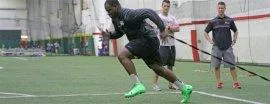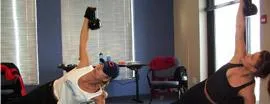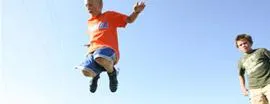Physical Education Injuries: 150% Increas
Physical Education Injuries alarm bells
IYCA Member, Mike Howard, sent me a link to this incredible article.
I was floored.
Stunned.
And completely annoyed.
150% increase Physical Education injuries .
Read the article and then be sure to leave me your comments about
why exactly you think this has become such a problem.
I feel very strongly that I know the answer.
And tomorrow I’m going to tell you what it is.
But for now, I want to hear your thoughts.
Here’s the article:
New national study finds increase in P.E. class-related injuries
Annual number of cases increased 150 percent from 1997-2007
Physical education (PE) in schools is one of the main tools used to increase physical activity and to prevent childhood obesity, and PE-related injuries are on the rise. Although increasing physical activity may reduce obesity, it may also increase the risk of injury. While recognizing that PE classes and physical activity are important components in combating obesity, parents and school administrators should remain vigilant for injuries. A recent study conducted by the Center for Injury Research and Policy of The Research Institute at Nationwide Children’s Hospital, found that the number of PE-related injuries to elementary, middle and high school students in the United States increased 150 percent between 1997 and 2007.
According to the study, published in the online issue of Pediatrics, the most common PE-related injuries were lower-extremity sprains and strains (23 percent), followed by upper extremity sprains and strains (14 percent) and fractures (14 percent). Middle school-aged children (11-14 years of age) accounted for the majority of PE-related injuries (52 percent). Elementary school-aged children (5-10 years of age) had almost double the odds of a head injury, compared with other injuries.
Nearly 70 percent of PE-related injuries occurred while children were participating in six activities (running, basketball, football, volleyball, soccer and gymnastics). Injuries were caused by contact with another person, playing surface, equipment, stationary structures, pulled muscles, overuse and activity-related illnesses such as heat stroke.
"The 150 percent increase in PE-related injuries presenting to emergency departments was consistent across gender and age groups. It is unlikely that this increase was attributable to an increase in PE participation," explained study author Lara McKenzie, PhD, principal investigator at the Center for Injury Research and Policy at Nationwide Children’s Hospital and faculty member of The Ohio State University College of Medicine. "Identifying patterns of PE-related injuries is the first step toward preventing them. Injury prevention education should be made a priority for all PE activities, especially for those activities with the highest injury rates."
This is the first published study to examine PE-related injuries on a national level. Data for this study were collected from the National Electronic Injury Surveillance System (NEISS), which is operated by the U.S. Consumer Product Safety Commission. The NEISS dataset provides information on consumer product-related and sports and recreation-related injuries treated in hospital emergency departments across the country.

High School Strength Coach Certification

Certified Speed & Agility Specialist

Kettlebell Instructor Course

IYCA Insiders - Exclusive Access

Youth Fitness Specialist Certification

Long Term Athlete Development

Youth Nutrition Specialist Certification

Copyright © 2008 - 2025 International Youth Coaching Association. All Rights Reserved
|
|

